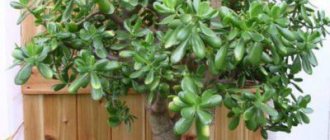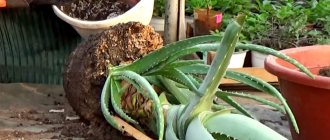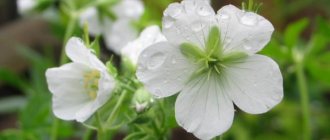Cypress is often used to create hedges. Not everyone knows that a noble coniferous plant with a beautiful pyramidal crown and bright greenery is suitable for decorating not only gardens, but also apartments. For a good microclimate in your home, many gardeners advise growing beautiful indoor cypress.
Care at home requires some knowledge and adherence to rules, which can be learned from the article. In most cases, a coniferous plant takes root well in the garden and in the home, if there is no excessive dryness of the air.
Features of caring for this indoor flower
In gardening, cypress has proven itself to be a rather unpretentious plant, but in indoor conditions, cypress shows some capriciousness. So how can you care for it at home and can you keep it there?
A nuance immediately after purchase
In flower shops, cypress trees grow in transfer pots, inside of which there is peat. Most often, the plant is very cramped in such a container, and its root system just begs to come out. Therefore, an evergreen tree needs to be replanted as soon as possible. After purchasing, you need to wait 6-7 days and transplant the cypress into a new, convenient pot. The above time is necessary for acclimatization.
When purchasing cypress, be careful. Plants like Kochia and Taxodium are very similar to what you need. Kochia is not evergreen, and Taxodium, although a cypress family, is deciduous.
Trimming
Some gardeners are inclined to believe that it is undesirable to prune indoor cypress, since its crown does not grow in large volumes. But most still recommend pruning. Cypress, depending on the variety, can be given the following forms:
- Ball.
- Cone.
- Spiral.
ATTENTION! In the last version you need to try really hard to make it really beautiful. If you have no experience in this matter, then it is better not to take risks, otherwise the plant will look, to put it mildly, unspectacular.
Pruning is carried out in the spring, when the plant is completely dry. It cannot be sprayed before the procedure. Excess shoots are removed entirely (cutting them in half is prohibited).
If necessary, pruning can be done in the fall.
Lighting
Cypress loves light very much, but does not accept direct rays of the sun. The ideal option is year-round diffused lighting.
If your plant is on a windowsill on the west or east side, it will need to be shaded at certain times. Accordingly, in summer the cypress is not placed on the south window; it will only be good in this part of the house in winter.
Lack or excessive amount of light is harmful to cypress , as it will negatively affect the development and growth of the plant. In the first case, the branches will stretch strongly upward and crumble, in the second case they will turn yellow.
Temperature
When growing cypress at home, it is very important to observe seasonality. Consider the fact that the natural conditions of the plant are subtropical.
The optimal temperature for cypress in summer is 20-30 degrees Celsius. But in winter you need to create conditions of about 5-10 degrees Celsius. During frosts, the root system of the plant freezes completely.
How to plant?
Planting and care at home is a simple procedure. If you have already bought an adult tree, you only need to replant it after acclimatization. The pot should be 3-4 times larger than the root system of the plant. It is best to choose a clay container. In plastic pots, the soil dries out quickly and cools down in winter, which will negatively affect your pet.
You can also purchase seeds at a flower shop, or remove brown seedlings from a pine cone. The landing scheme in this case is as follows:
- Seeds are planted in wide bowls.
- After 14-20 days the first shoot appears.
- After 30 days, tiny cypress trees can be planted in permanent pots.
How to transplant?
Young specimens need frequent replanting. The procedure is carried out annually in late spring, but as it grows, the frequency decreases. Mature cypress trees are replanted only if necessary.
IMPORTANT! You need to replant very carefully and carefully, transferring the plant from one pot to another. The slightest damage to the root system will lead to the death of the cypress.
Subtleties of transplantation:
The container is selected several sizes larger than the previous one.- A drainage layer must be placed at the bottom (expanded clay, shards, sphagnum moss or coals can be used). The layer is a couple of centimeters.
- Pour a small layer of soil.
- Replant the plant.
- Add the required amount of soil on top so that it does not touch the neck of the root.
Problems during cultivation
Such an exotic plant can bring some troubles to an inexperienced owner that must be resolved. The most common problem is why indoor cypress dries out.
- Drying and yellowing of indoor cypress needles. Try to spray your tree regularly; the crown does not have enough moisture.
- Drying is spotty. Most likely, a nearby radiator or air conditioner is covering the plant with hot air, drying out that particular side. This needs to stop.
- Shedding of needles. It's all about bright light; place the flowerpot with the tree in partial shade or simply remove it from direct rays.
- Deformation of the trunk, the tree stretches to one side. The cypress does not have enough light and is trying to get closer to its source. Tip: change the location of the flowerpot. Trimming a cypress tree is only necessary for cosmetic purposes; it will not correct the curvature of the trunk.
- The change in color of the needles to yellow is the result of insufficient watering.
There are not many pests on cypress, but if you notice insects, take measures and use special chemicals.
After reading our article, you have learned enough to grow beautiful and neat cypress yourself right at home. We wish you success!
Soil for the plant
Soil for cypress can be bought at the store; substrate for coniferous plants is suitable. The optimal mixture for full growth:
- Leaf soil - two parts.
- Sod land - three parts.
- River sand (coarse) – one part.
The soil must be loosened, otherwise the plant will die. A drainage layer is necessary to prevent water stagnation at the roots.
If you decide to feed your “pet,” buy fertilizer at a flower shop that is intended specifically for this plant. Garden fertilizers cannot be used.
Landing
The method of planting cypress trees is practically no different from planting other conifers. It can be divided into successive stages:
- Purchasing seedlings or propagating existing plants. It is not recommended to purchase seedlings near roads or in markets; it is better to do this in specialized stores. It is better if the planting material is sold with a root container.
- Choosing a location. The plant loves the sun, but does well in shaded areas. You should avoid damp and foggy areas; it is better to plant the tree on an elevated area, but in one that is not exposed to strong gusts of wind and drafts.
- The soil. Soil for cypress plays an important role. It is better to select fertile loamy soil. It should be light and porous.
Step-by-step instructions for planting cypress:
- The best time to plant a plant is April. Then the soil will have thawed sufficiently.
- The tree is planted in holes at least 90 cm deep and 60 cm wide. The bottom is covered with a drainage layer of gravel or brick with a layer of up to 20 cm.
- A special substrate is prepared to cover the root. It consists of earth, humus and sand. To speed up the establishment of a plant in a new place, you can add 300 g of nitroammophoska.
- The seedling is placed in a prepared hole and sprinkled with the prepared soil mixture.
- The tree trunk circle is mulched with sawdust or peat with a layer of 7 cm.
Caring for a cypress tree does not require much effort or expense. The tree needs regular watering and feeding. Loosening and mulching is carried out in the same way as for other conifers. To maintain shape, formative pruning is carried out, and preventive pruning is carried out to protect against pests and diseases.
It is important to consider that the tree requires preparation for winter.
Watering and fertilizing
The variety does not tolerate dry weather well, so watering should be abundant and timely. A mature tree is watered once a week with 10 liters of water, and a young tree - 2-3 times.
To feed the cypress tree, a special fertilizer for coniferous trees is used. It can be purchased at a specialty store or nursery. It is recommended to apply fertilizers in mid-summer, and then begin to prepare the plant for cold weather.
Loosening and mulching
After each watering, you need to loosen the top layer of soil. This is required so that air can flow to the root. With this procedure, the mulch layer often collapses and must be maintained. Mulch is useful because its presence allows you to pay less attention to watering.
Trimming
It is better to do sanitary and preventative pruning in the spring. During the process, dry and diseased branches are removed
This should be done with extreme caution so as not to damage the green shoots, because the tree grows very slowly. They can only be touched if the crown is too thick
How does it reproduce?
Cypress can be propagated in two ways: by seed and cuttings.
Seminal
- After purchasing seeds, they need to be stratified (treated with cold). To do this, the seed material is placed in the refrigerator for 3 months.
- Before planting, the seeds are soaked in warm water for 24 hours.
- Planting is carried out in boxes where the drainage is crushed bark, and the main soil is sawdust mixed with sand. The containers are placed in a dark place, the soil is constantly moistened.
- The seeds germinate partially. Those that have successfully made it, when they reach 5-6 centimeters, are sent to separate pots.
Read more about growing cypress from seeds here.
Cuttings
- When pruning a tree, cuttings with a “heel” are cut.
- The leaves are removed from the petioles. Place them together in the “root” solution for 24 hours.
- The media is sprinkled with crushed coal.
- Petioles are planted in the same soil as for seed propagation. The third part should go deeper.
- The soil is moistened.
- Cover the material with glass jars. Ventilation is carried out every week for about an hour.
- In a couple of months, rooting will occur.
Reproduction
Cypress can be propagated by cuttings or seeds. To germinate seeds, they are sown on a mixture of sand and peat. Sawdust or moss will also work. The mixture should be moist. Leave the seeds in a warm and well-lit place for about 2 months. During this time, they will have time to germinate and can be planted in small containers where they will take root. When replanting for the first time, you should not touch the roots, just transfer the plant along with the earthen ball into a new pot and add a little new substrate.
Cuttings are cut from fresh shoots in spring and summer. Remove all the needles from the bottom of the cutting and plant it in the ground. Some people advise treating it with a biostimulant before burying it, and then sprinkling the cut with charcoal. Place the planted cuttings in greenhouse conditions (for example, under glass or polyethylene), and after a few months it will take root.
Watering and air humidity
In summer, cypress consumes a lot of liquid and needs frequent watering. It is recommended to water the cypress tree daily in the summer.
At the same time, the main thing is not to overdo it, otherwise the root system will begin to rot. In hot weather, the plant needs to be sprayed (only with settled water at room temperature).
In winter, watering is reduced. Settled water is also used.
Types of cypress trees
Sometimes it’s hard to believe that two different species are the same cypress, they are so different. In our latitudes we are most often talking about pyramidal cypress. But we will tell you about several more interesting options!
pyramidal cypress
It came to us from the warm regions of Italy, and it is the only European species. In nature, it lives in the Mediterranean, but has been successfully grown by gardeners for more than 200 years. The crown height in the wild sometimes reaches 35 m.
Photo: krugosvetka.icu
Swamp Cypress
It is also called taxodium, and it lives in swampy regions of the United States. This is a tall, large tree with a powerful massive trunk and a thick crown. Specimens with a trunk diameter of about 12 m are known.
Photo: pibig.info
Arizona cypress
It was this that became the basis for many breeding varieties with a decorative blue crown. In nature, it lives in the mountains and lives up to 500 years, stretching up to 20 m during this time.
Photo: buyprivacytrees.com
Common cypress
This is an Asian variety with a narrow, short crown. It is interesting that its branches are almost horizontal, unlike most of its relatives. They are just very short, so in general the crown is cone-shaped.
Photo: vdberk.ru
Mexican cypress
A heat-loving species that researchers evaluated more than 400 years ago. It is huge, with a wide and spreading crown, but even here the outlines of the pyramid are preserved.
Photo: carib.ru
Dwarf cypress
A beautiful ornamental variety of compact size, which also grows very slowly. The height of the tree with small green needles rarely exceeds 50 cm.
Photo: stroy-podskazka.ru
Lobularia (50 photos): types, care and planting in open ground
Benefits and harms
The benefits of cypress in the home are very significant.
Useful qualities
First of all, cypress will fit perfectly into the interior before the New Year. Put some tinsel on it and you have a Christmas tree.
The wood of the plant secretes phytoncides , which kill moths and suppress the development of microbes, staphylococcus and E. coli.
The climate in the room where cypress grows is very pleasant, filled with a pine aroma.
REFERENCE! According to Church tradition, cypress is a tree from the Garden of Eden, which is a symbol of eternal life.
Medicinal properties
Pros of growing cypress indoors:
You provide your family with excellent prevention against bronchitis and colds.- The plant is recommended to be grown by those people whose cough is asthmatic in nature.
- Cypress will benefit those who want to quit the bad habit of smoking.
- The subtle aroma of essential oil calms the nervous system.
As a result, we can say that cypress does not cause any harm. Caring for cypress at home is not very easy, but it is worth it. As a result, you will receive not only a beautiful plant, but also undoubted benefits for your health.
Cypress – photo
Cypress is a real salvation for northern regions with fleeting summers, where it is so difficult to have time to enjoy the greenery in all its glory. This evergreen tree fully compensates for such a lack of impressions!
Photo: sovetik-sad.ru
Photo: krugosvetka.icu
Photo: treespk.ru
Photo: ru-pole.ru
Photo: pinterest.com
Photo: freeartbackgrounds.com
Photo: na-dache.pro
Photo: classpic.ru
Photo: plantmaster.com
Photo: plantfinder.ir
Photo: pinterest.ru
Photo: profile.ru
Photo: pinterest.com
Photo: sortved.ru
Photo: vestikavkaza.ru
Photo: www5.toplamakalisveris.co
Photo: pxhere.com
Photo: domashniecvety.ru
Photo: thepresentation.ru
Photo: landscapetnik.com
Photo: molbiol.ru
Photo: sadydachi.su
Photo: plants.ces.ncsu.edu
Photo: 2sotki.ru
Did you like the post? Subscribe to our channel in Yandex.Zen, it really helps us in our development!











